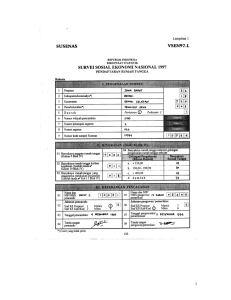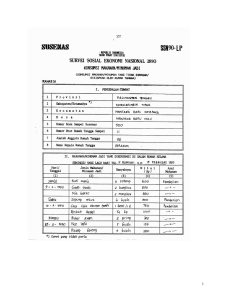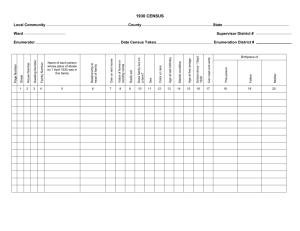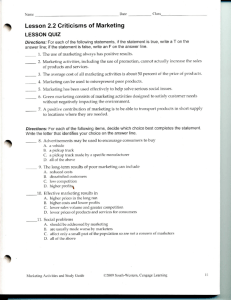NATIONAL SOCIO-ECONOMIC SURVEY SUSENAS 2002
advertisement
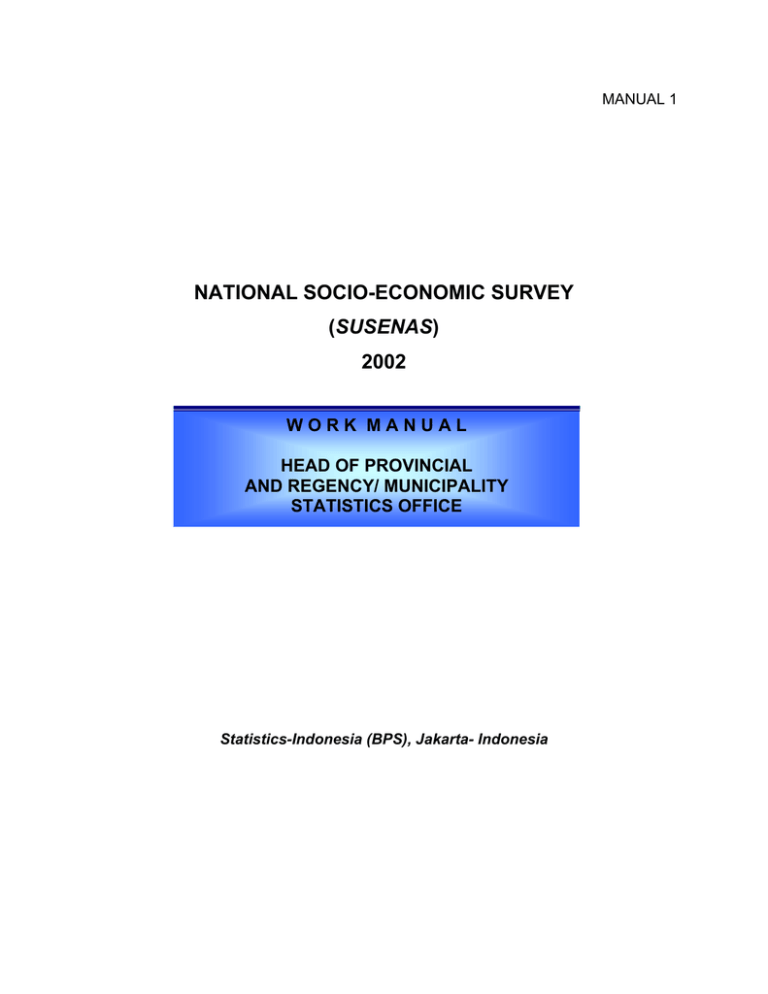
MANUAL 1 NATIONAL SOCIO-ECONOMIC SURVEY (SUSENAS) 2002 WORK MANUAL HEAD OF PROVINCIAL AND REGENCY/ MUNICIPALITY STATISTICS OFFICE Statistics-Indonesia (BPS), Jakarta- Indonesia CONTENTS CONTENTS I. A. B. C. D. E. F. G. PREFACE General Objective Scope Schedule of Activities Type of Collected Data Type of Lists and Documents Used Arranged Statistic II. A. B. C. D. E. F. G. H. METHODOLOGY Sample Outline Sample Design Census Block Map Sketch Number of Census Block Sample and Household Selected Census Block List Household Sample Selection Estimation Method Data Collecting Method III. A. B. C. D. E. F. FIELD ORGANIZATION Realization Guarantor Field Officers Training Field Officers Training Field Officers Tasks Others ATTACHMENTS LIST Attachment 1 : Census Block Map Sketch Attachment 2 : Number Of Census Block Sample, SUSENAS 2002 Core Household, And Module Core Attachment 3 : Census Block Sample List Attachment 4 : Monthly Household Expenditure Group by Province Attachment 5 : Random Digit Table Attachment 6 : Number Of SUSENAS Core Officer And Module Core Attachment 7 : Number Of SUSENAS 2002 Class And National Instructor Core Attachment 8 : Number Of SUSENAS 2002 Class, Module Core National Instructor Attachment 9 : Number Of SUSENAS 2002 Class, National Instructor, Local National Instructor And Central National Instructor Attachment 10 : Indonesia Function Classification Code 1982 Attachment 11 : Age Calculation Formula QUESTIONNAIRES LIST 1. VSEN2002.L 2. VSEN2002.DSRT 3. VSEN2002.K 4. VSEN2002.M 5. VSEN2002.LPK I. PREFACE A. General In order to implement their tasks, The Central Bureau Of Statistic (BPS) is responsible to provide data needed for planning sectional and cross sectional development. To observe the situation, monitor, and evaluate the implementation of the development program, the availability of continuous data is very helpful in making correction of an existing program if it is necessary. The social data produced by BPS were collected through Population Census (SP), Population Survey between Census (SUPAS), National Labor Survey (SAKERNAS), and National Social economic survey (SUSENAS). Since 1992, some core data can give a description about population welfare, which is collected every year through SUSENAS. Development progress could be evaluated gradually because of the availability of yearly data/ information. SUSENAS is designed in order to collect social population data, which is relatively in the wide scope. Data collected are included education, health/ nutrition, housing/ environment, criminality, social culture action, consumption, and income of household, travel, and household welfare. In 1992, SUSENAS data collecting system was renewed. Information which is used to arrange population welfare indicator in module (information is collected every three year) is joined in to core (information is collected every year). At that time being, SUSENAS provides tools that can be used to supervise population welfare level, formula government program, and analyze population welfare improvement programs impact. In the new SUSENAS core, consist some questions asking about condition and member of population attitude, which have tight relationship with welfare aspects. Here are some example question “are you still attend school”, “are you in health disruption”, “how do you take care your health”, “who was the birth helper”, “how long the baby got the wet nursing” and immunization to the children also be asked. Beside all question above, also been collected education info, household economic activity, and especially for the ever- married women have been asked about age when she got married, number of child, and Family Planning attitude. Explanation from the module has taken turns to be collected in 3 years. At the first year, household income and expenditure were collected, at the second year household welfare socio-culture, trips and criminality module were collected, and finally at the last year health, nutrition, education and housing were collected. Information is module is more detail and comprehensive question if it is compared to the same topic question in the core. For example, education information collected in core is limited to education level of household member. However, in module it is widen to detail education cost questions. In core it only asked, “ do you do travelling?” in module, it asked more detail about characteristic and cost of the trip. Questions in core are collected in order to get important information to anticipate some changes that could be happened every year. They are also helpful for short- term planning, and the questions could be related to module’s questions such as expenditures. Questions in module are useful to analyze problems, which are unneeded to be supervised every year or to analyze government intervention, such as poverty and malnutrition. SUSENAS is potential to describe people welfare. For example, to describe various components of welfare, it could be arranged various aggregate data as indicator of school participation level, family planning acceptor percentage, average age on the first marriage, average number of child birth, percentage of household that gets clean water or lavatory with septic- tank, and average expenditure per capita. Joined core- module data will produce analysis to answer questions such as, “does poor group get proper advantage of education program implemented by government (for example, 9- years school program)”, “who uses government education program subsidy”, “is there certain family planning tool used by poor people more than others”, “is there any relationship between working hour and fertility”, and “is sanitation related to health status”. SUSENAS data is potential to cover some data availability gap needed by decision-makers in many fields. Some important things to do in the future are formulating panning problems, supervising, or evaluating to find out solution. Because of technology improvement, computerizing, make analysis working easier and indirectly SUSENAS data become more socialized. Since 1993, sample size of SUSENAS core is enlarged to produce simple statistic in Regency/ Municipality level. This- new progress gave data analyzers a new dimension. At that time being, some Regencies have been arranged their people welfare statistic/ indicator. I hope that all Regency will follow them although it is realized in order to be able to arrange the indicator, local statistic bureau officers need some training. SUSENAS data users are being more various and wider implemented. Statistic bureau task is to provide with better quality, good timing, and comprehensive. B. Objective In general, the objectives of collecting data through SUSENAS are providing data of community welfare (Kesra) that reflects the social and economic conditions of the community. Specifically 2002 SUSENAS goals are: (i) Provide raw data about people welfare, which is very important to make policies, and also to act as tool to supervise and evaluate the development; (i) Provide detail data about household consumption expenditure, in Rupiah and quantity; to estimate pattern of people consumption, sufficiency of nutrition consumption, expenditure distribution, poverty level, etc. C. Scope The 2002 SUSENAS is conducted in all areas in Indonesia with the 214,144 households sample size in the urban and rural area. Because of the unfavorable security situation, in these following Provinces/ Regencies SUSENAS 2002 is only conducted in Banda Aceh (Aceh), Ambon (Maluku), Ternate (North Maluku), Sorong (West Irian Jaya), Timika (Central Irian Jaya) and Jayapura (East Irian Jaya). Sample in those provinces is only for core household. Special households, which live in special block census like military complex, jail, dormitory, and other special households are not chosen as sample. The core data is collected using the VSEN2002.K, consumption module data using VSEN2002.M. D. schedule of activities Activity 1. Document sending from BPS 2. Training a. Main instructor b. National instructor c. Local officials 3. Implementation a. Household listing Date Early November 2001 August 27th – September 1st 2001 October 1st- 6th 2001 nd October 22 - November 15th 2001 (February 1st- 28th 2002) January 1st- 31st 2002 (March 1st- 31st 2002) January 15th- February 5th 2002 (March 15th- April 5th 2002) February 1st- 28th 2002 (April 1st- 30th 2002) b. Household sample selection c. 4. Household enumeration List checking a. Regency/ Municipality Statistic Bureau b. Provincial Statistic Bureau 5. Training of processing data (data edit and entry) officers 6. Core data and core- module set data Regency and Province 7. Document sending to BPS a. VSEN2002.M list (Statistic Population welfare Bureau) b. VSEN2002.DSRT list (Statistic Methodological Bureau) c. DSBS list (Statistic Methodological Bureau) 8. entry in February 20th- March 10th 2002 ( April 20th- May 10th 2002) March 1st- 31st 2002 (May 1st- 31st 2002) March 2002 (May 2002) March – April 2002 (May – June 2002) March – April 2002 (May – June 2002) March – April 2002 (May – June 2002) March – April 2002 (May – June 2002) Processing at BPS a. VSEN2002.M list b. VSEN2002.DSRT list Core data entry result sending to BPS April – May 2002 (June - July 2002) April – May 2002 (June – July 2002) 9. Headquarter April – May 2002 (June – July 2002) Evaluation and result discussion June – July 2002 (August – September 2002) 10. Publication August – September 2002 (October – November 2002) 11. Poverty line/ poor people calculation 12. July – August 2002 (September – October 2002) Remark: If there were no Additional Budget (ABT), valid schedule is in the bracket E. Type of data collected 1. Data Collected by Core Questionnaire (VSEN2002.K) including: a. General characteristics on household member (name, relationship with head of household, sex, age, marital status); b. Characteristic of head of household’s ethnic; c. Characteristic of health including people health condition, household expenditure on health; d. Characteristics of education of household member ages > 5 years old; e. Characteristics of economic and labor activities of household member ages> 10 years old; f. Characteristics of fertility for ever- married women and pregnancy- prevention attitude for married women; g. Characteristics of housing including house- ownership, quality of household building, and household facilities; h. Characteristics of household consumption in average and main source of household income; i. 2. Characteristics of social – economic condition of household. Data collected by consumption module questionnaire (VSEN2002.M) including: Characteristics on consumption and expenditure of household such as detail data about household expenditure consumption differed on food and non- food consumption without seeing the source of items. F. Type Of Lists And Documents Used No. Type of list Purpose Done by Pair Stored in 1. Census Block Map sketch To identify working area boundary and selected census block Supervisor 1 BPS Regency/ Municipality 2. Census Block Map list (DSBS) To identify selected census block Supervisor - BPS Headquarter/ Provincial BPS 3. VSEN2002.L Household listing Enumerator 1 Provincial BPS 4. VSEN2002.DSRT Sample of selected Household list/ core-module Supervisor/ Editor 2 BPS Headquarter/ Provincial BPS 5. VSEN2002.K Core household enumerating Enumerator 1 Provincial BPS 6. VSEN2002.M Consumption module household enumerating Enumerator 1 BPS Headquarter No. G. Type of Document Purpose Stored in 1. Manual Book I Manual Of Provincial, Regency/ Municipality Statistic Bureau Provincial, Regency/ Municipality Statistic Bureau 2. Manual Book II.A Manual Of Core Enumerator Supervisor And Enumerator 3. Manual Book II.B Manual Of Core Supervisor Supervisor 4. Manual Book III.A Manual Of Consumption Module Enumerator Supervisor And Enumerator 5. Manual Book III.B Manual Of Consumption Module Supervisor Supervisor 6. Manual Book IV Manual Of Age Conversion Supervisor And Enumerator Arranged Statistic Various type of statistic that are used to describe economic and social conditions can be found in 2002 SUSENAS core and module. Then, development planners to observe, monitor, and evaluate the successful of development will use those data. Statistic data which are arranged from 2002 SUSENAS activity can be differed into 4 indicators, they are: 1. Population Welfare Objective Indicator For National And Province Level This indicator comes from core data collecting. It covers a) indicators of individu such as population, health, education, labor, fertility, and family planning, and b) indicator of household such as housing and expenditure. The indicators arranged at Regency/ Municipality level make the accuracy of the enumeration done by enumerator in field easier. 2. Population Welfare Indicator From Consumption/ Expenditure And Poverty Level For National And Provincial Level Point Of View This indicator comes from data collecting of food (in Rupiah and unit) and non- food consumption/ expenditure module. II. METHODOLOGY A. Sample Outline The 2002 SUSENAS Sample outline consists of 3 types, they are: sample outline for Sub- Regency selection (special for rural area), sample outline for census block selection, and sample outline for household selection. Sample outline in Sub- regency selection in rural area is sub- regency list in every Regency/ Municipality, which is sorted geographically. Sample outline in block census selection in urban area is census block list, which is differed by census block in big city, Medium City, and Small City in every regency/ municipality. For rural area, census block selection uses census block list in ever selected sub- regency. Sample outline in household selection is household list in VSEN2002.L Block IV. B. Sample Design The 2002 SUSENAS sample is prepared for estimation at regency/ municipality level. The 2002 SUSENAS sample design in urban area is a- two steps sample design and three steps sample design in rural area. Sample selection for both urban and rural area is done separately. For urban area, first step, selecting some block census by systemic linear sampling from sample outline. The second step, selecting 16 households by systemic linear sampling from every census blocks. For rural area, first step, selecting some sub- regencies by probability proportional to size from sub- regency sample outline (size = number of households in sub regency). The second step, selecting some census block sampling by systemic linear sampling from sub- regency. selecting 16 households from every census blocks. Moreover, the last, 2002 SUSENAS SAMPLE SELECTION CHART URBAN AREA CB is sorted by: Big city, medium city, and small city in every Regency/ Municipality RURAL AREA Sub- regency is sorted geographically in every Regency/ Municipality Selecting some subregencies by PPS with the number of households per subregency Selecting some CB by systematic sampling Selected census block*) Selected Sub- regency Selecting some SB by systematic sampling Selecting 16 HH by systemic sampling 16 HH selected Selected Census Block*) Selecting 16 HH by systemic sampling 16 HH selected Remark: CB= Census Block HH= Household *) Census Block core – module Census Block core Census block Acceleration for National digit : Sample Code Number first digit, digit 1 : Sample Code Number first digit, digit 2 : Sample Code Number first digit, digit 3 Sample used for estimation at provincial level is sub- sample from selected sample for estimation at Regency/ Municipality level for both urban and rural area. Those are selected by systemic sampling from block census list in every regency/ municipality for both urban and rural area. Then, the selected census blocks (subsamples) named census block of core- module because they are also being enumerated by core questionnaire. Otherwise, the census blocks for estimation at provincial level (census block of module- core) are selected by systemic sampling from selected census block list in every regency/ municipality (core census block). The 2002 SUSENAS unselected census block of core- module is named core block census. To fasten the presentation of 2002 SUSENAS estimation results at national level, some census block are selected from core- module census block sample. The sample is selected by systemic sampling. C. Census Block Map Sketch Every 2002 SUSENAS supervisor has to make the copy of map sketch of census block, SP2000-SWB on a piece of F4 paper before fieldwork (attachment 1). SP2000-SWB was made by 2000 Population Census officers. Enumerators to identify their census block area boundaries will use the copy. If there was any legends or clear boundaries which does not exist in field, the 2002 SUSENAS officers have to correct it (copy of SP2000-SWB). In listing household by VSEN2002.L activity, the enumerator has to enumerate every physical building, physical census and household in the selected census block area. D. Number of Census Block Sample and Household Number of the 2002 SUSENAS census block sample and household for every province (core- module census block) and for estimation at regency/ municipality level (core census block) is attached in “Attachment 2”. Sample of sub- regency (for rural area) and census block (for urban area) for estimation at regency/ municipality level is located in regency/ municipality proportionally with number of households in regency/ municipality. Regency/ municipality that has big number of households will have sample more than regency/ municipality that has small number of households. E. Selected Census Block List In 2002 SUSENAS census block list (Attachment 3), every selected census block is coded by Sample Code Number (NKS). The 2002 SUSENAS NKS consists of 4 digits which are serial number of selected census block list in every regency/ municipality and arranged as following: a. First digit is Core - Module Sample, Core and Acceleration. Code 1 = Module – core, code 2 = Core, Code 3 = Acceleration (panel 10.000) b. 001 – 499, is serial number of selected census block in rural area. c. > 501, serial number of selected census block in urban area. Remark: 1. In the list of census block, sample column 5 has information of Local Environment Unit (SLS). It has to be checked the accuracy by 2002 SUSENAS supervisor/ editor. If it is not correct, fill in the right one in this column.. If it is not the same or empties, the supervisor/ editor has to fill the right information on SLS. The result will be sending to BPS attn Statistic Methodological Bureau. 2. The column 9 of 2002 SUSENAS census block sample list has number of households enumerated by 2000 Population Census (SP 2000). The number has to be used to check the accuracy of the number of 2002 SUSENAS households listed in the same census block. If there is a sharp difference, the supervisor/ editors have to check to the field to find out the reason of the difference. If uncorrected area was enumerated, the enumerator has to correct the list by VSEN2002.L in the correct area. If it is corrected, take a note the reason in column 10 of 2002 SUSENAS census block sample list. F. Household Sample Selection As explained above, number of household sample to be selected in every census block is 16 households. Supervisor/ Editor conducted the selection of household sample by systemic sampling after receiving household list in every census block (VSEN2002.L) from enumerator. Supervisor/ editor has to calculate sample interval and first random digit in every census block. Sample outline used for household selection is household list in column 8 to 10, Block IV, VSEN2002.L. To fill in-group of monthly household expenditure in column 8 to 10, enumerator has to use Monthly Household Expenditure Group table by province, which is differed by urban area and rural area as shown in Attachment 4. Household Sample Selection Procedures The procedures of household sample selection for supervisor/ editor are as following: a. Check whether the “check mark” (√) in column eight to column 10 done by enumerator is right, every ordinary household cannot have more than one √ mark, or even does not have the √ mark. b. Give the √ mark serial number in column 8 from one to the last number. If it, from the first page to the last page, is completed, do the next number to the √ mark in column 9 and column 10. c. Please check whether the serial number of the last √ mark in column 10 shows number of households in selected census block (the fill has to be the same as the last serial number of household in column 5). If it is not the same, there must be a mistake in column 5 or column 8 to column 10. Correct the mistake before selecting the sample. d. Count The Sample Interval (I) for household selection : I= Number of household from household list 16 Sample interval is counted up to two digits behind coma. e. Use Random Digit table (see Attachment 5) to decide first random (R.1), which the value is smaller than, or equal with sample interval (I). f. Circle the serial number on the same √ mark with the first random digit (R.1)., then use sample interval to count the next random digit, they are R.2, R.3, ……, R.16 as following: g. R.2 = R.1 + I; R.3 = R.1 + 2I; . . . R.16 = R.1 + 15I Circle the serial number of the same √ mark in column 8 to column 10 with the selected random digit. If the serial number in column 8 to column 10 has circled, the number of physical building, census building, and serial number of household which are in column 3, column 4 and column 5 have to be circled as well. Note the 16 households in VSEN2002.DSRT List. This VSEN2002. Double the DSRT list, one for enumerator (kept in Provincial BPS) and the other one is for Statistic Methodological Bureau. G. Estimation Method Below is formula to predict the 2002 SUSENAS realization result in a domain in urban or rural area: Urban area: y ku = 1 16bu bu 16 i =1 j =1 ∑ ∑y ij Yˆku = Pˆku y ku y ku Ŷku = Predicted mean value of y at regency/ municipality k area u = Predicted total value of y at regency/ municipality k area u bu = Characteristic value at sub regency’s - j selected census block- i = Number of selected census block at regency/ municipality k area u P̂ku = Predicted number of households at regency/ municipality k area u y ij Rural Area: y kr = 1 16br n br 16 j =1 i =1 t =1 ∑ ∑ ∑y tij Yˆkr = Pˆkr y kr y kr = Predicted mean value y at regency/ municipality k area r Ŷku = Predicted total value y at regency/ municipality k area r =Characteristic value at sub- regency - j , selected census block- i , y tij household- t br = Number of selected census block at regency/ municipality k area r P̂kr = Predicted number of household at regency/ municipality k area r Predicted mean value y at regency/ municipality k area u and r is: Yˆ + Yˆ Yˆk(u+r ) = ku kr Pˆku + Pˆkr Predicted total value y at regency/ municipality area ( Ŷkr ) is Yˆk (u + r ) = Yˆku + Yˆkr Predicted total value y k Urban area ( Ŷku ) and rural at province level urban area ( Ŷ pu ) or rural area ( Ŷpr ) of regency/ municipality, counted by formula below: Yˆpu = T ∑ Yˆku k =1 T And Yˆpr = ∑ Yˆkr k =1 T= Number of regency/ municipality at province p . Predicted total value y at province level in urban area ( Ŷ pu ) or rural area ( Ŷ pr ) is: Yˆp(u + r ) = Yˆpu + Yˆpr Predicted mean value y at province level in urban area ( u ) and rural area ( r ) is: y p( u + r ) = Yˆpu + Yˆpr Pˆpu + Pˆpr Predicted total value y at national level is counted by this formula below: Yˆn(u + r ) = L ∑ (Yˆpu + Yˆpr ) p =1 L = Number of provinces in Indonesia Predicted mean value y at national level is counted by formula: y n(u + r ) = Yˆn(u + r ) = H. Yˆn(u + r ) Pˆ n (u + r ) Predicted number of households in Indonesia in urban area and rural area Data Collecting Method Data collecting in every selected household is conducted by direct interview between enumerator and respondent. Please ask the individual questions in 2002 SUSENAS’s questionnaire to the person (respondent) himself. The characteristics of household can be collected by interviewing head of household, spouse of head of household, or household member who knows the characteristics asked. III. FIELD ORGANIZATION A. Realization Guarantor 1. Central Bureau of Statistic (BPS) Head of BPS is responsible to all 2002 SUSENAS activities, and also to give instruction, technical and administration direction on SUSENAS realization both in headquarter or local. In order to implement his authority and responsibility, head of BPS might organize technical team to have its advice on related matters (an advisor team). The technical caretaker for 2002 SUSENAS data collecting is Director of Population Welfare Statistic. 2. Provincial BPS 1. Be responsible to 2002 SUSENAS activities at province integrally. Technical activities caretaker for 2002 SUSENAS is Head of Statistic Bureau of Population welfare. 2. Coordinating 2002 SUSENAS enumeration in all area, based on the direction. 3. Distributing all documents to Regency/ municipality BPS. 4. Giving direction to head of BPS at regency/ municipality about number of officers needed based on the direction. 5. Coordinating recruitment and officer’s training procedures. 6. Supervising 2002 SUSENAS realization and evaluating the result. 3. BPS Regency/ Municipality 1. Be responsible to 2002 SUSENAS activities at regency/ municipality level integrally. The caretaker for technical activities is head of Statistic section of population welfare. 2. Realizing the direction from head of Provincial BPS, such as officers’ mobilization, field supervising, etc. 3. Distributing all documents to SUSENAS enumerator. 4. Supervising 2002 SUSENAS enumeration realization and evaluating the answers of the list. B. Field Officers 1. 2002 SUSENAS Enumerators (PCS) a. Participating the 2002 SUSENAS field officer’s training b. Enumerating based on working area direction and the schedule c. Re-checking the enumeration result (documents completeness, answering completeness, and collected data quality) d. Submitting 2002 SUSENAS documents that have been filled and checked to supervisor/ editor 2. 2002 SUSENAS Supervisor (PMS) a. Participating 2002 field officers’ training b. Supervising based on the direction, working area and the schedule c. Checking the 2002 SUSENAS enumeration result from enumerators (documents completeness, answering completeness, and collected data quality) d. Giving the best direction and solution of any problems that asked by enumerators. e. Organizing his/ her enumerators f. Collecting and arranging all enumeration result documents to send to Regency/ Municipality BPS Number of enumerators and supervisors needed by every province is shown in Attachment 6. C. Training The procedures of forming skilled field officers are using three steps training systems. First, the informant trains Core Instructors (Intama). Second, Core Instructor (Intama) that has been trained trains National Instructor (Innas) and the last step the National Instructor that has been trained trains field officers (enumerator and supervisor). The first step training (Intama’s class) which is organized for four effective days has some subjects, some of the are methodology, field organization, 2002 SUSENAS concept and definition. This training uses discussion (dialogical) method. The next training -it is also organized for 4 effective days- is to train national instructor (Innas). The objective is to make Innas more skilled in giving instruction to field officers. Finally, the trained Innas will teach officers how to collect data, fill the questionnaire, and inform the concept and definition. Criteria to be a National Instructor (Innas) is the one who works in field related to social – population and minimum has Bachelor degree. D. Field Officers training The 2002 SUSENAS enumerators is Statistic officers or Statistic partner who is experienced in enumerating SUSENAS. Number of core officers training day is 4 days (2 effective days), and core supervisor will be trained for 5 days (3 effective days). Number of Core- Module training day is 6 days (four effective days), and the Core- Module supervisor’s is 7 days (five effective days). Number of class and Innas can be seen in Attachment 7 to Attachment 9. Criteria to be Enumerator/ Supervisor: 1. Minimum graduate from Senior High School 2. Preferably ever been SUSENAS enumerator/ supervisor and have good performance in training or other BPS surveys. E. Working Load for Field Officers a. A field Officer at Core Block has two selected census block working load in. A field officer at Core – Module census block has one selected working load. b. A supervisor supervises and checks enumeration results done by 4 field officers. F. Others a. Regarding to the inconsistency of labor data mainly that is related to Labor type code from SAKERNAS and SUSENAS, 2002 SUSENAS labor type classification uses 1982 Indonesia Labor Classification (KJI 1982) (Attachment 10) b. Field officers have age conversion book to identify respondent’s age easily. (Attachment 11) c. Questionnaires used in 2002 SUSENAS can be shown in Questionnaire list
